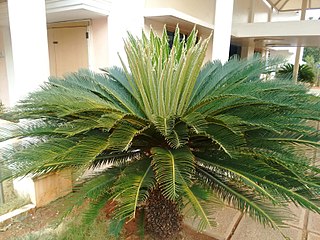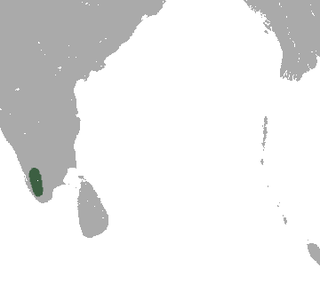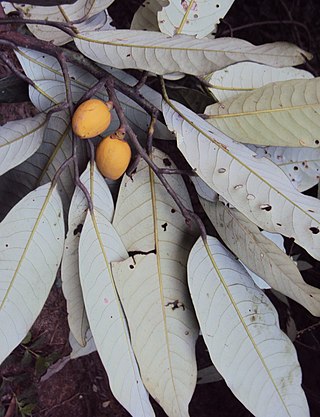
The Servarayan hills, with the anglicised name Shevaroy Hills, are a towering mountain range near the city of Salem, in Tamil Nadu state, southern India. It is one of the major hill stations in Tamil Nadu and in the Eastern Ghats.

The Eastern Ghats are a discontinuous range of mountains along India's eastern coast. The Eastern Ghats pass through Odisha, Andhra Pradesh to Tamil Nadu in the south passing some parts of Karnataka as well as Telangana. They are eroded and cut through by four major rivers of peninsular India, viz., Mahanadi, Godavari, Krishna, and Kaveri. Deomali with 1672 m height is the tallest point in Odisha. Arma Konda/Jindhagada Peak with 1680 m is the highest point in Andhra Pradesh. BR hill range located in Karnataka is the tallest hill range in Eastern Ghats with many peaks above 1750 m height. Kattahi Betta in BR hills with the height of 1822 m is the tallest peak in Eastern Ghats. Thalamalai hill range in Tamil Nadu is the second tallest hill range. Araku range is the third tallest hill range.Edakkal Caves in Wayanad district is present in between Western Ghats and Eastern Ghats and is connecting Wayanad plateau and Nilgiri plateau.

Cycas is a genus of cycad, and the only genus in the family Cycadaceae. About 113 species are accepted, which are native to the Asia-Pacific, East Africa and Madagascar. Cycas circinalis, a species endemic to India, was the first cycad species to be described in western literature, and is the type species of the genus. The best-known Cycas species is Cycas revoluta.

Sri Venkateswara National Park is a national park and biosphere reserve in Tirupati of Andhra Pradesh, India. The total area of the park is 353 km2. The park is known for its many waterfalls, including the Talakona, Gundalakona and Gunjana. As the government of India declared the Seshachalam Hills as one of the biosphere reserves of India in 2010, this national park becomes the part of it.
Colonel Richard Henry Beddome was a British military officer and naturalist in India, who became chief conservator of the Madras Forest Department. In the mid-19th century, he extensively surveyed several remote and then-unexplored hill ranges in Sri Lanka and south India, including those in the Eastern Ghats such as Yelandur, Kollegal, Shevaroy Hills, Yelagiri, Nallamala Hills, Visakhapatnam hills, and the Western Ghats such as Nilgiri hills, Anaimalai hills, Agasthyamalai Hills and Kudremukh. He described many species of plants, amphibians, and reptiles from southern India and Sri Lanka, and several species from this region described by others bear his name.

Ophisops beddomei, commonly known as Beddome's snake-eye or Beddome’ s lacerta, is a species of lizard in the family Lacertidae. The species is a diurnal and fast-moving terrestrial lizard, which is endemic to the Western Ghats of India.

The Deccan thorn scrub forests are a xeric shrubland ecoregion of south India and northern Sri Lanka. Historically this area was covered by tropical dry deciduous forest, but this only remains in isolated fragments. The vegetation now consists of mainly of southern tropical thorn scrub type forests. These consist of open woodland with thorny trees with short trunks and low, branching crowns; spiny and xerophytic shrubs; and dry grassland. This is the habitat of the great Indian bustard and blackbuck, though these and other animals are declining in numbers; this area was at one time home to large numbers of elephants and tigers. Almost 350 species of bird have been recorded here. The remaining natural habitat is threatened by overgrazing and invasive weeds, but there are a number of small protected areas which provide a haven for the wildlife. Trees in these forests have adapted to not require much water.

Nepenthes khasiana is an endangered tropical pitcher plant of the genus Nepenthes. It is the only Nepenthes species native to India. It is thought to attract prey by means of blue fluorescence.

The Changtang is a part of the high altitude Tibetan Plateau in western and northern Tibet extending into the southern edges of Xinjiang as well as southeastern Ladakh, India, with vast highlands and giant lakes. From eastern Ladakh, the Changtang stretches approximately 1,600 kilometres (990 mi) east into Tibet as far as modern Qinghai. The Changtang is home to the Changpa, a nomadic Tibetan people. The two largest settlements within the Tibetan Changtang are Rutog Town the seat of Rutog County and Domar Township the seat of Shuanghu County.

Cycas beddomei is a species of cycad in the genus Cycas, native to India, where it is confined to a small area of Andhra Pradesh state in the Tirumala Hills in scrubland and brush covered hills.

Salim Ali's fruit bat is a rare megabat species in the monotypic genus Latidens. It was first collected by Angus Hutton, a planter and naturalist in the High Wavy Mountains in the Western Ghats of Theni district, Tamil Nadu in South India in 1948. It was initially misidentified as a short-nosed fruit bat (Cynopterus) but later identified by Kitti Thonglongya as a new species and was named after Indian ornithologist Salim Ali in 1972.

Cyanotis is a genus of mainly perennial plants in the family Commelinaceae, first described in 1825. It is native to Africa, southern Asia, and northern Australia.

Bentinckia nicobarica is a species of flowering plant in the family Arecaceae found to occur in the Nicobar group of islands in the Bay of Bengal. It is an endemic palm occurring in Great Nicobar, Katchal, Nancowry and Car Nicobar Islands.

Myristica dactyloides is a species of plant in the family Myristicaceae. It is endemic to Sri Lanka. The species was earlier thought to occur in India because two subspecies of the related Myristica beddomei found in India, namely M. b. beddomei and M. b. ustulata, were wrongly identified as M. dactyloides Gaertn. in many herbarium specimens and regional floras.

Cyanotis cristata is a species of perennial plants in the family Commelinaceae. It is native to Indian Subcontinent, southern China, Southeast Asia, Ethiopia, Socotra, Mauritius, Java, and the Philippines.
The Ch. Devi Lal Rudraksh Vatika Herbal Nature Park, in short Rudraksh Vatika, is a 184 acre forested wildlife area, wetland and herbal park for the conservation of biodiversity of over 400 endangered ayurvedic medicinal herbs in Shivalik foothills of Himalayas. It is located on the western bank of Western Yamuna Canal, 1.3 km east of NH-907, in Chuharpur Kalan village of Yamunanagar district of Haryana state in India.

Cyanotis axillaris is a species of perennial plants in the family Commelinaceae. It is native to Indian Subcontinent, southern China, Southeast Asia and Northern Australia. It grows in monsoon forest, woodland and wooded grassland. It uses medical plant in India and it uses as food for pigs.

Eulophia obtusa, a showy and distinctive species of orchid, popularly known as the ground orchid, recorded from Bangladesh, North India and Nepal. This orchid growing in seasonally in grassland. It is a grass associated orchid species. A Bangladesh based renowned botanist and ornithologist Md Sharif Hossain Sourav first described this rare species from Bangladesh in 2017. There are only three collections in the Kew Herbarium dates from 1902, which suggests that it is quite a rare species. It is assessed as critically endangered (CR) in Bangladesh according to the IUCN Red Listing criteria. Very recently this species was rediscovered in India after 118 years.

Cyanotis beddomei, the teddy bear vine, is a species of flowering plant in the family Commelinaceae, native to Kerala and Tamil Nadu states in southern India. It has gained the Royal Horticultural Society's Award of Garden Merit. It may be synonymous with Belosynapsis kewensis.

















